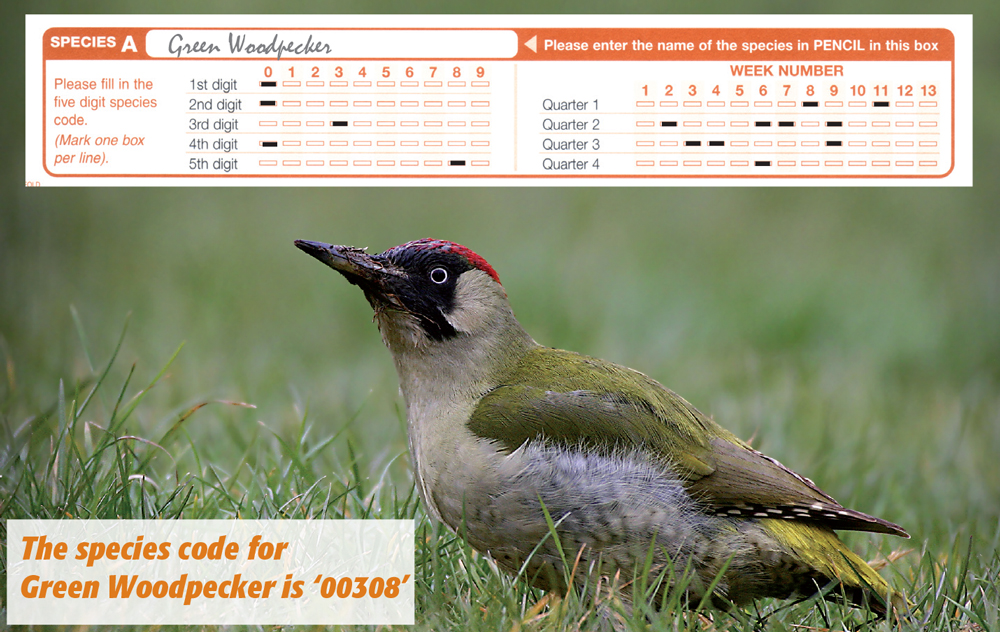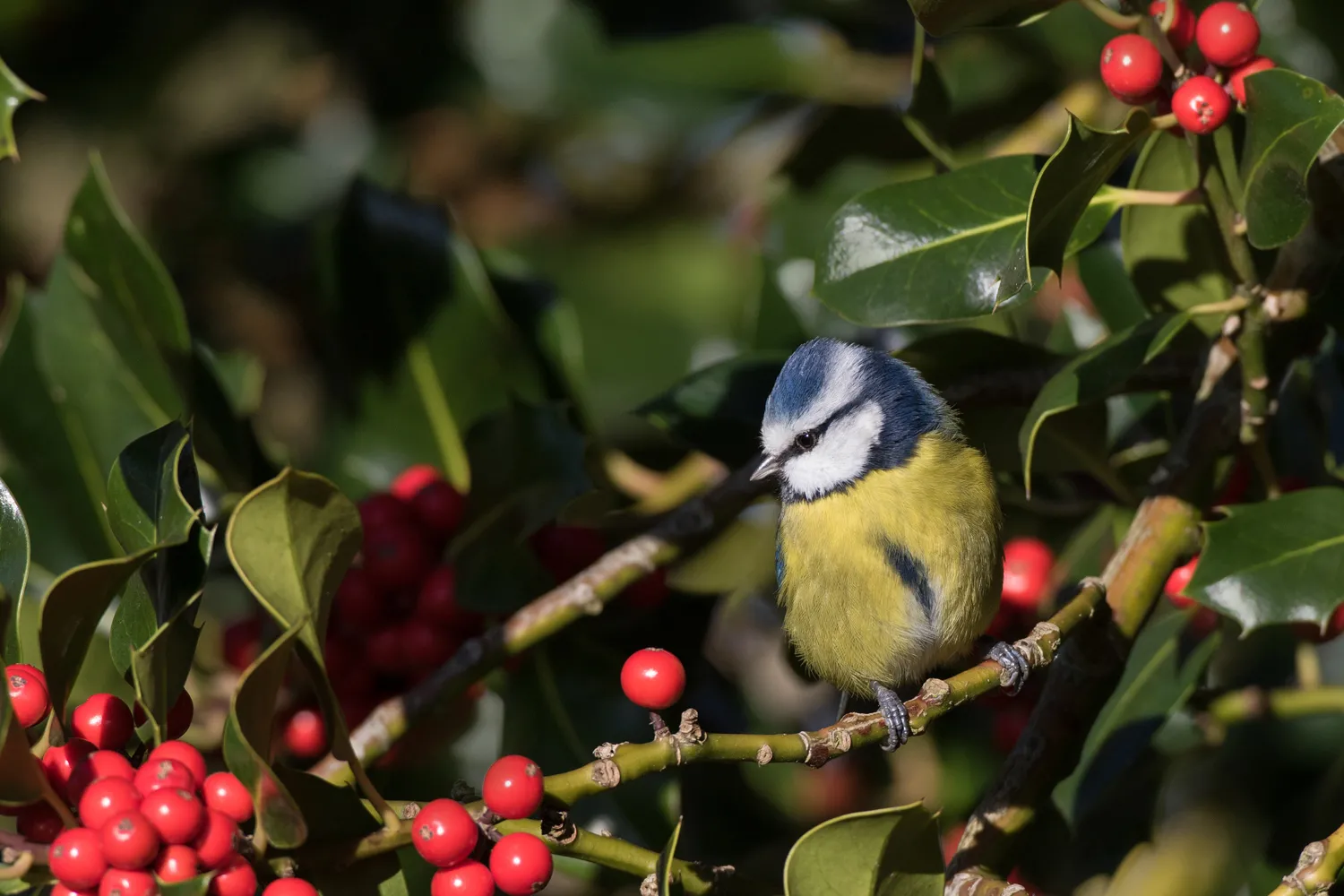A small percentage of Garden BirdWatch participants complete their recording on paper forms, which are submitted quarterly. Typically, these are individuals who do not have access to a computer and our GBW Online web application.
The paper forms are a simple way of telling us about your garden wildlife. One form can be used to tell us about common garden birds, while the other can be used to tell us about less common birds and other forms of garden wildlife. From time to time we run other one-off surveys using similar paper forms and the following guidelines on how to complete and look after the forms will help you with these as well.
The information collected on our paper forms will be read by a scanning machine, which detects the marks that you place in the boxes on the form. Consequently, care needs to be taken when completing the forms, as dirt, smudges or even erased pencil marks can confuse the scanner. Please look after your forms; they must be clean and flat for the machine to accept them. If a form becomes creased or dirty just ask us for another one.
Please look after your paper forms by following these guidelines:
- Only place marks in the appropriate boxes.
- Do not write anything on the form except for your name and address, which should be placed in the boxes provided.
- You might find it useful to keep your observations in a notebook (or one of our weekly log sheets) and then transfer these to the form at the end of the week.
- Do not attach anything to your form (especially staples) except for Post-it notes, which are best attached to the front of the form next to your name and address.
- When posting your count forms, please fold them carefully in half with a single fold along the centre line, which is marked ‘fold here’. As protection against creasing you may wish to include a piece of card (that from a breakfast cereal packet works well) in with the form when you mail it back to us.
- Please take care not to exceed the maximum weight or size for the stamp used, as we have to pay a substantial surcharge on any underpaid postage.
- You may find that an A5 envelope is the best size to use.
It’s easy to make a mistake and mark an incorrect box. Don’t panic! Carefully white out the entire incorrect box with correcting tape. If you do not have tape, or if many corrections are required, it is probably best to include a separate note of the corrections needed. We’ll do our best to sort the form out for you.
Entering your Garden BirdWatch number
It is essential that you record your Garden BirdWatch number on every form, using the special box(es) provided. Mark the first digit of your Garden BirdWatch number by inking in the box under the appropriate digit in the line marked 1st digit, mark the second under the corresponding number in the line marked 2nd digit and so on.
The Garden BirdWatch Count Form
The main Garden BirdWatch Count Form covers the 42 most commonly reported bird species nationally. Each form covers one quarter of the year (13 weeks) and everybody sends their form in at the end of each quarter.
This form is made up of three tables, plus boxes for your name/address, Garden BirdWatch number, year and quarter.
TABLE A allows you to record the occurrence and numbers of ten widespread species. For each species, please record the size of the largest group of individuals seen together at any one time during your recording period. See our QUICKSTART GUIDE for instructions on how to set up your recording area and how and what to record.
TABLE B (on the back of the form) lists 31 other common species (with Marsh Tit and Willow Tit lumped together because they are difficult to separate in the field). If you see any of these species in your garden during your recording period simply place a mark in the relevant box to denote their presence.
Bird species not listed in either TABLE A or TABLE B can be recorded on the OTHER WILDLIFE FORM, as can various other types of garden wildlife.
TABLE C should be used to tell us about the foods (and water) that you provide. You do not have to provide food or water in order to participate in the survey.
Filling in the Garden BirdWatch Count form
Enter your name and address in case you make a mistake when entering your GBW number.
Check which year, quarter and week we are on by looking at the CALENDAR OF COUNT WEEKS that appears on the inside front cover of Bird Table magazine.
Enter your GBW number, year and quarter on both the front and the back of the form.
Enter your observations of the bird species you have seen for TABLE A and TABLE B. For TABLE A, you can record the number of individuals seen together at any one time by using the flock size categories.
The Other Wildlife Recording Form
Garden BirdWatch is primarily about recording common garden birds. However, many participants choose to record less common birds and other garden wildlife. Those recording on paper use the Other Wildlife Recording Form to do this.
Instead of having named species on it, this form requires you to look up the SPECIES CODE for a species seen in the garden during the course of the year — this form covers a whole year, rather than just a single quarter. Use the WILDLIFE GUIDE included in your pack to look up the species code and, if needed, check your identification. See the example below, which uses Green Woodpecker to illustrate how to fill in the boxes.
We send out two of these forms with the end of year mailing, ready for use the following year. If you have lots of species visiting then please ask us for additional forms. You should return completed forms at the end of the year.
If you find that a species is not in your Wildlife Guide or on the main Garden BirdWatch Count Form, please use the code ‘99999’ and enter the name of the species in the box provided. We may be able to load your observations of this species.

Some common questions
Should I record birds seen in flight?
Because we are interested in birds that are using the resources that your garden provides, most birds seen in flight above your garden would not be recorded. There are some instances when a bird seen in flight will be using your garden and one of the best examples of this is when low-flying Swifts, Swallows and House Martins are hawking for insects. Often this happens in the evening or on a dull day, times when aerial insects are low to the ground. Use your common sense and be consistent from one week to the next in the way that you record.
What should I do if I go away on holiday?
If you go away on holiday then you simply leave blank the weeks on the paper recording form for when you are away. It is sensible to gradually reduce the amount of food you are putting out prior to your departure, so the birds have begun to find alternative sources of food before your food runs out.
Should I send in my form even it is very late?
Yes. If your form arrives late and we cannot include it in the initial data load, we can always add it to a later one.
Can I try recording online but then switch back to paper forms if I find that I prefer using the paper forms?
Yes, you can switch between the two methods very easily, just remember to let us know which you want to use. All of your records will be stored in the same place anyway.
